Grilled Chicken Breast
This Grilled Chicken Breast is incredibly juicy and tender thanks to an easy marinade flavored with fresh lemon, Dijon, and herbs. It’s cooked on a gas grill for caramelization and flavor. It’s fantastic on its own, or can be served with Chimichurri or Mango Salsa.
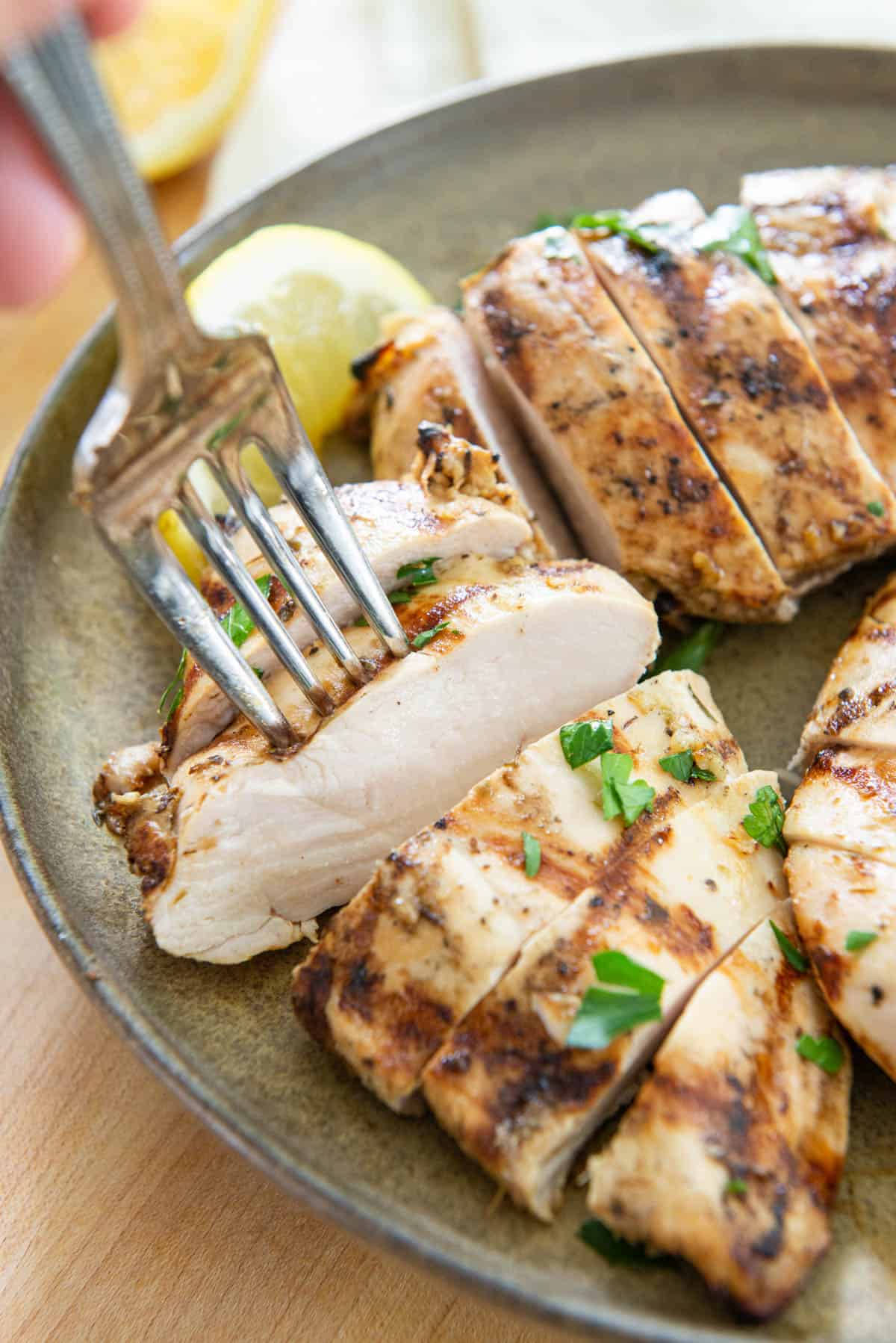
I’m a firm believer that grilled meats are the best meats of all, and no joke, I grill every single day.
While a Grilled Ribeye is my favorite meat of all, my kids love this grilled chicken breast the most out of any grilled meat I make. It’s easily one of our favorite chicken recipes as a family.
What’s Great About this Recipe:
Unbelievably juicy – The marinade really flavors and plumps up the chicken breast, and gives you a wonderfully juicy and tender meat. No dry chicken here!
Flavorful but not overpowering – This grilled chicken has enough flavor to be enjoyed on its own, but it’s also agreeable enough to be added to other dishes like Cobb Salad or a Kale Caesar Salad.
The marinade time is flexible – You can marinate the meat for as little as 30 minutes or as long as 24 hours, and I’ll give you tips for how to tweak the marinade to adjust to different times and your schedule.
The marinade is substitution friendly – I share ideas below for changing out herbs and ingredients for the marinade, so it’s easier to use what you have on hand.
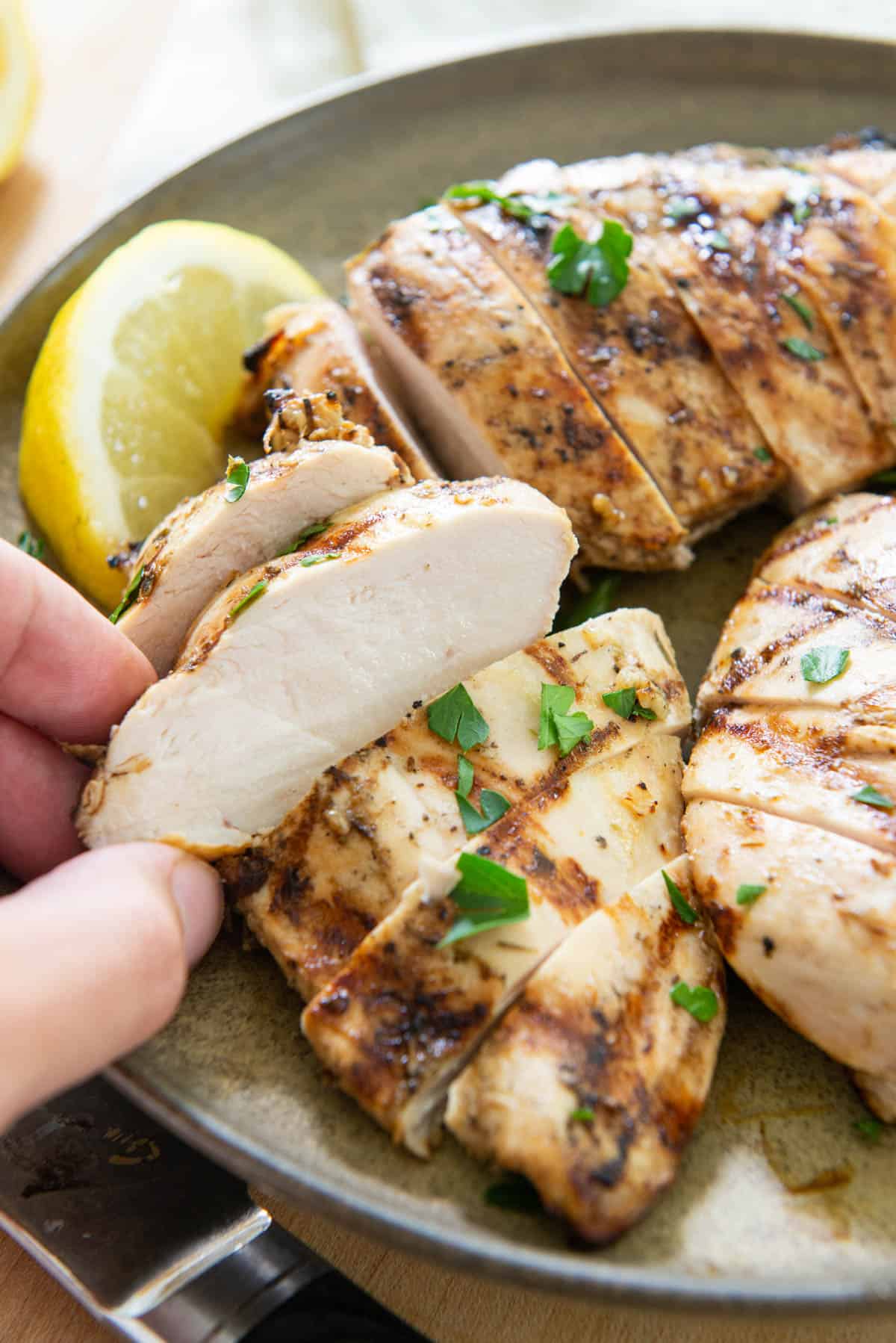
Look how insanely juicy that meat is. Only juicy chicken breasts here!
A Simple Marinade Does Wonders
For your grilled chicken marinade, you’ll need olive oil, fresh lemons, fresh garlic, Dijon mustard, dried thyme, kosher salt, and black pepper:
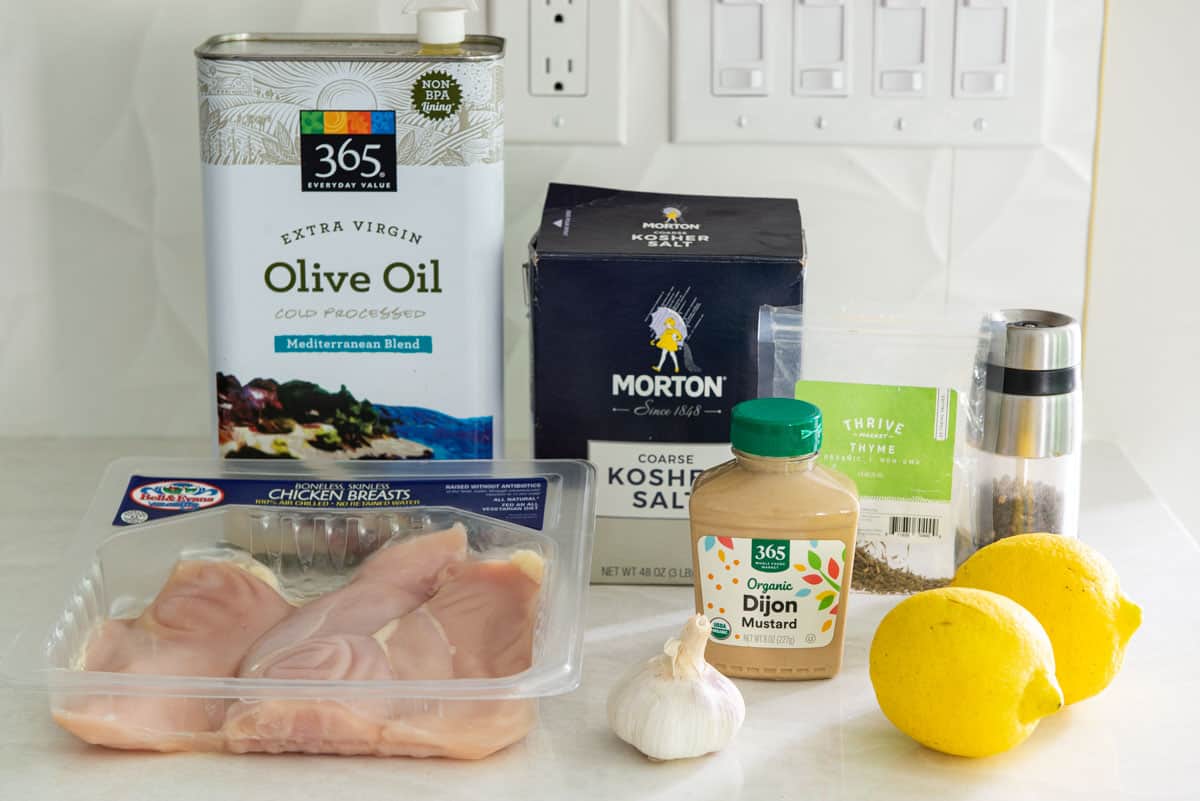
The marinade does double duty here, and is important for both flavor and juiciness. These ingredients will give you the most classic flavor, but you can make substitutions here as well.
Substitution Ideas for the Marinade
This to me is the best grilled chicken breast. The marinade tastes great but is also fairly neutral. Here are some other swaps you can make to maintain a balanced flavor profile.
Lemon juice – Limes are fantastic with chicken, and you can swap out an equal amount for the lemon juice.
Thyme – You can substitute dried oregano, rosemary, basil, or parsley here, or even do a mix. I like to use dried herbs for convenience, but you can also use fresh. Just double the amount used.
Dijon mustard – If you’re not a fan of mustard, feel free to swap in soy sauce, coconut aminos, balsamic vinegar, or a half amount of Worcestershire sauce.
Olive Oil – You can also use avocado oil here if you prefer, though I like the flavor of olive oil more.
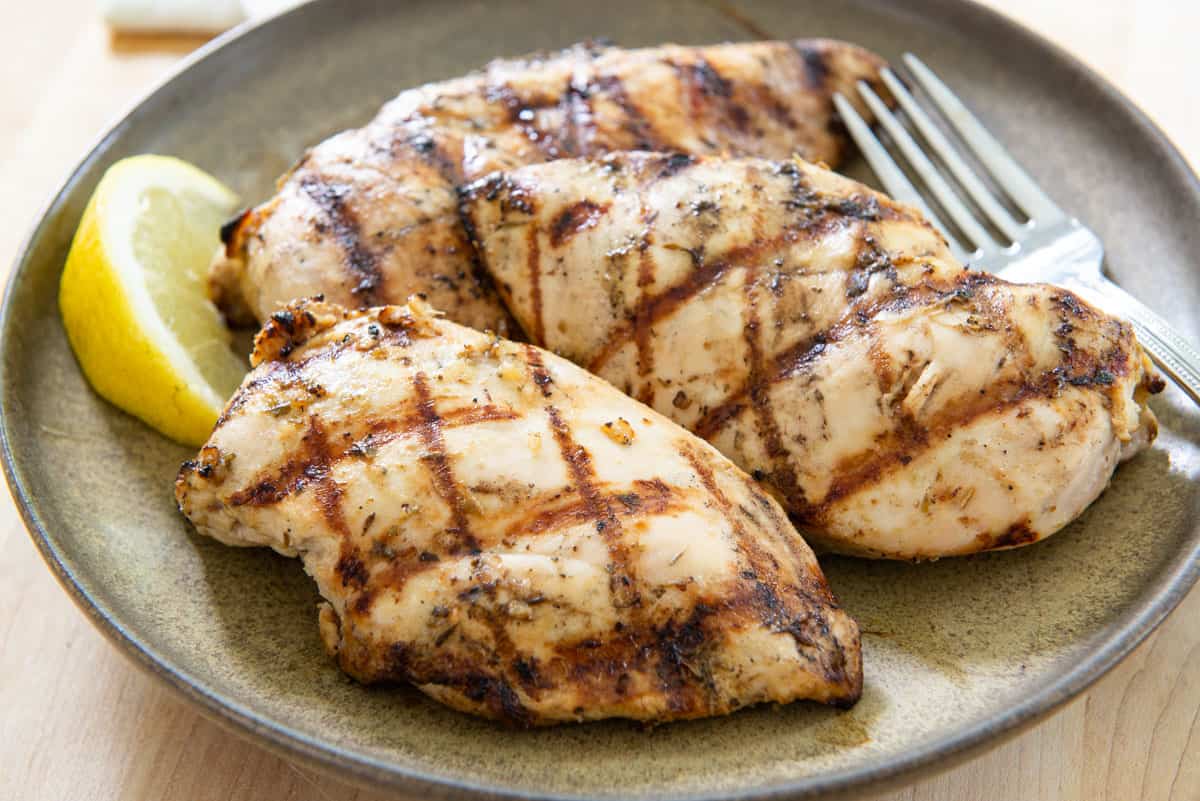
Tips for Buying the Best Meat
Buy quality chicken without added solutions – Look for air chilled chicken with no retained water. Yes, the low-quality chicken that’s injected with a solution of salt water and additives is cheaper, but it never tastes as good.
Buy smaller chicken breasts – If possible, stay away from gigantic pieces of chicken breast, as they tend to be tougher and more difficult to cook evenly. I recommend buying the smallest breast pieces you see. As a rule of thumb, the three pieces of meat I have here weighed 1.25lbs total.
If you can’t get smaller breast pieces that are less than 1″ thick, you will need to either pound them out flatter with a rolling pin or meat pounder to an even thickness, or slice through the middle to turn them into cutlets, which are just thin-cut chicken breasts.
It’s easier to start with smaller pieces of meat from the beginning. The ones I bought here didn’t need any pounding or prep at all.
Step by Step Guide:
Prepare the marinade
In a ziptop plastic bag, make the marinade by combining olive oil, lemon juice, Dijon mustard, garlic, dried thyme, salt, and pepper:
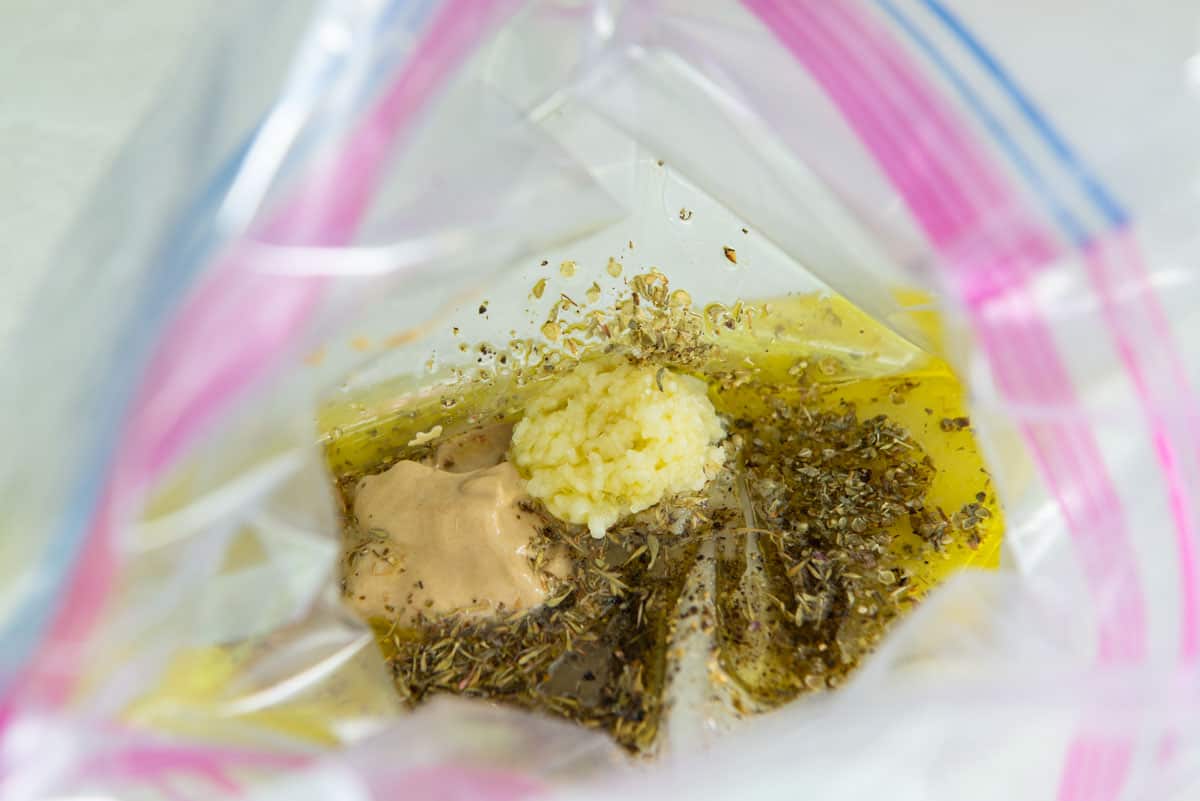
Shake it all together, then add the raw boneless skinless chicken breasts to the bag, making sure to squeeze out all the air and tightly seal the top.
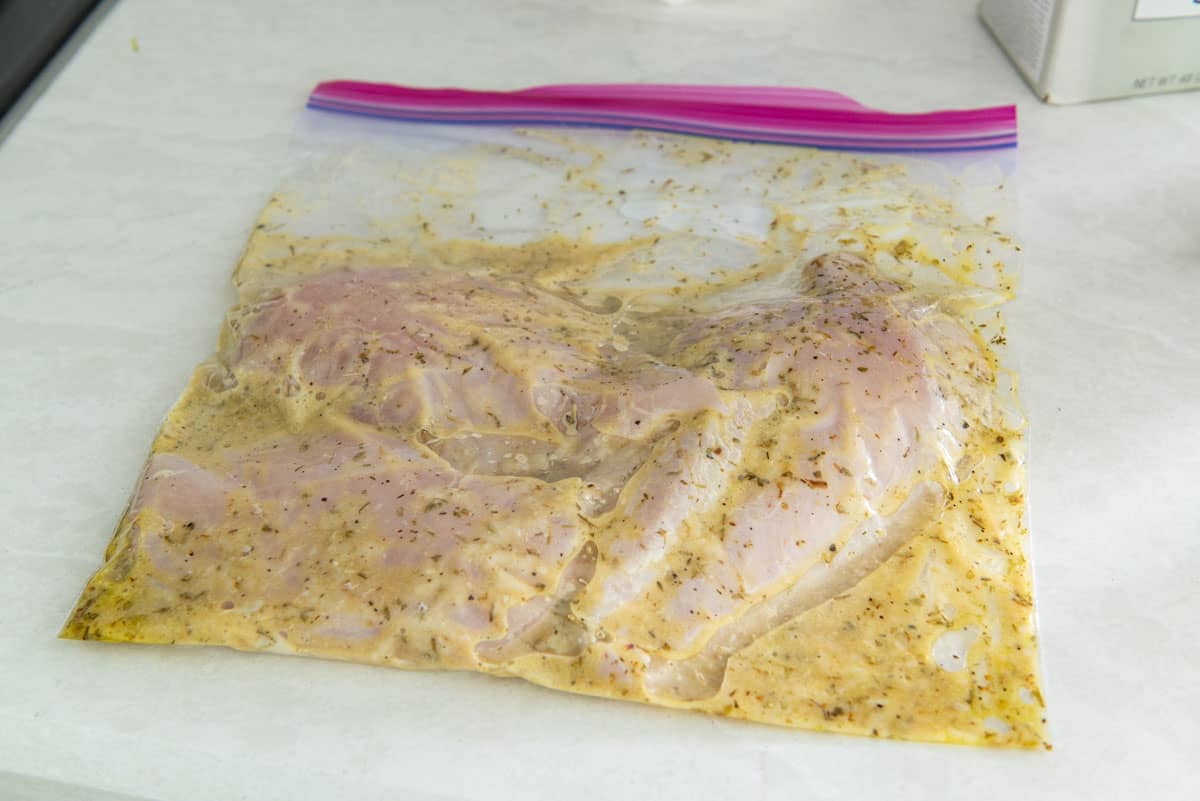
This gives you really flavorful chicken and also tenderizes the meat.
Why a plastic bag for marinating instead of a bowl?
Using a bag allows you to squeeze the air out and fully immerse all sides of the chicken in the marinade. This also allows you to use less marinade and avoid wasting ingredients.
Marinating Time Guidelines:
If you have an hour: This is the perfect amount of marinade time, and how this recipe was developed. In this case, leave the chicken at room temperature, not in the refrigerator. The FDA says that meat can rest safely on the counter for up to 2 hours, and letting it sit at room temp will give you a more tender and evenly cooked end result. It’s the same idea with this Glazed Spiral Ham and why it’s so good. A warmer starting temperature means less cooking which means less drying out the meat.
If you only have a half hour: the same applies as above. This the absolute minimum for marinating, and will be slightly less flavorful and tender than one hour, but I’ve done it.
If you want to marinate overnight: The chicken needs to be stored in the fridge in this case. Reduce the lemon juice by half, otherwise the meat will become overly tenderized by the acidity. Leave the chicken at room temperature an hour before cooking.
Time to Cook!
Preheat all three burners on a gas grill on high for at least 10 minutes, which should give the grill an internal temp of at least 600F (after you start cooking and opening/closing the lid, it should hover more around 400F, which is perfect).
Turn the setting down to medium heat and place the marinated chicken breasts on the grill grates:
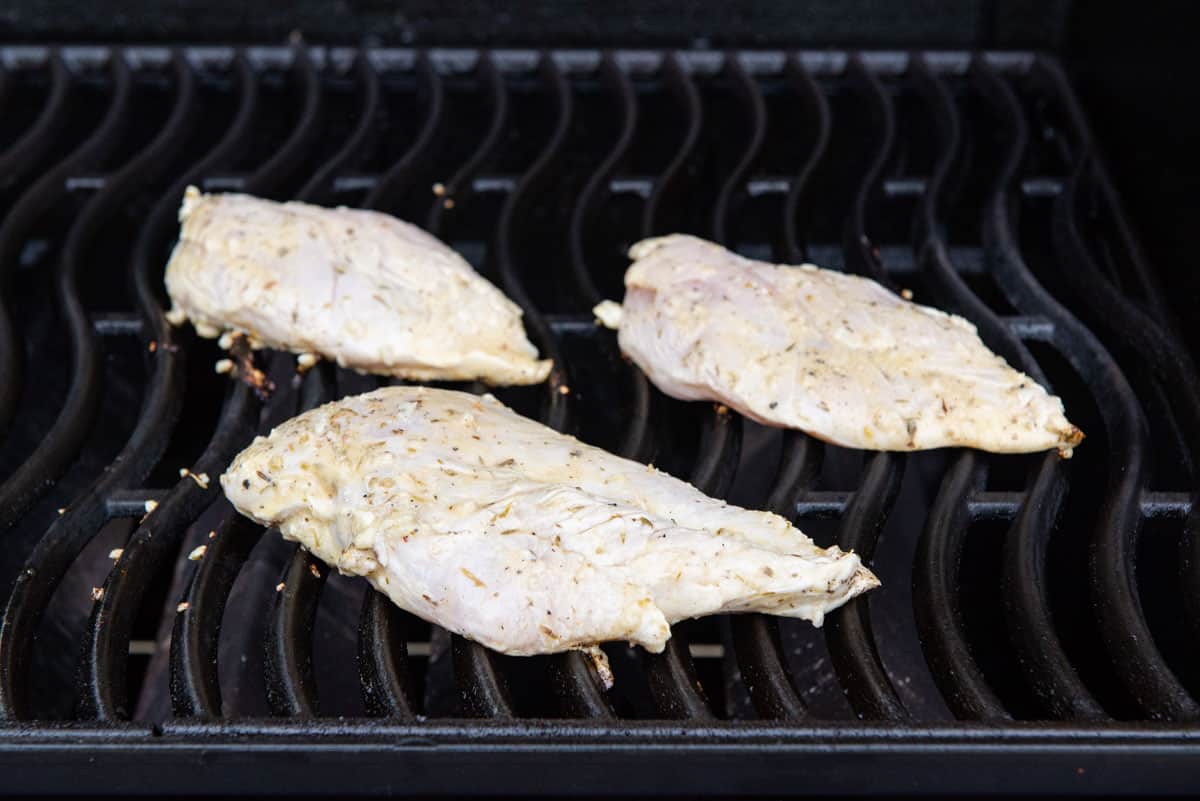
So long as the grill is sufficiently preheated, there is no need to pat the meat dry with paper towel first.
Close the lid, and let cook for 2 minutes, then turn the chicken breasts 90 degrees to give cross grill marks on the same side, and close the lid for another 2 minutes.
Check underneath that there is some good caramelization on the bottom, then flip the breasts over.
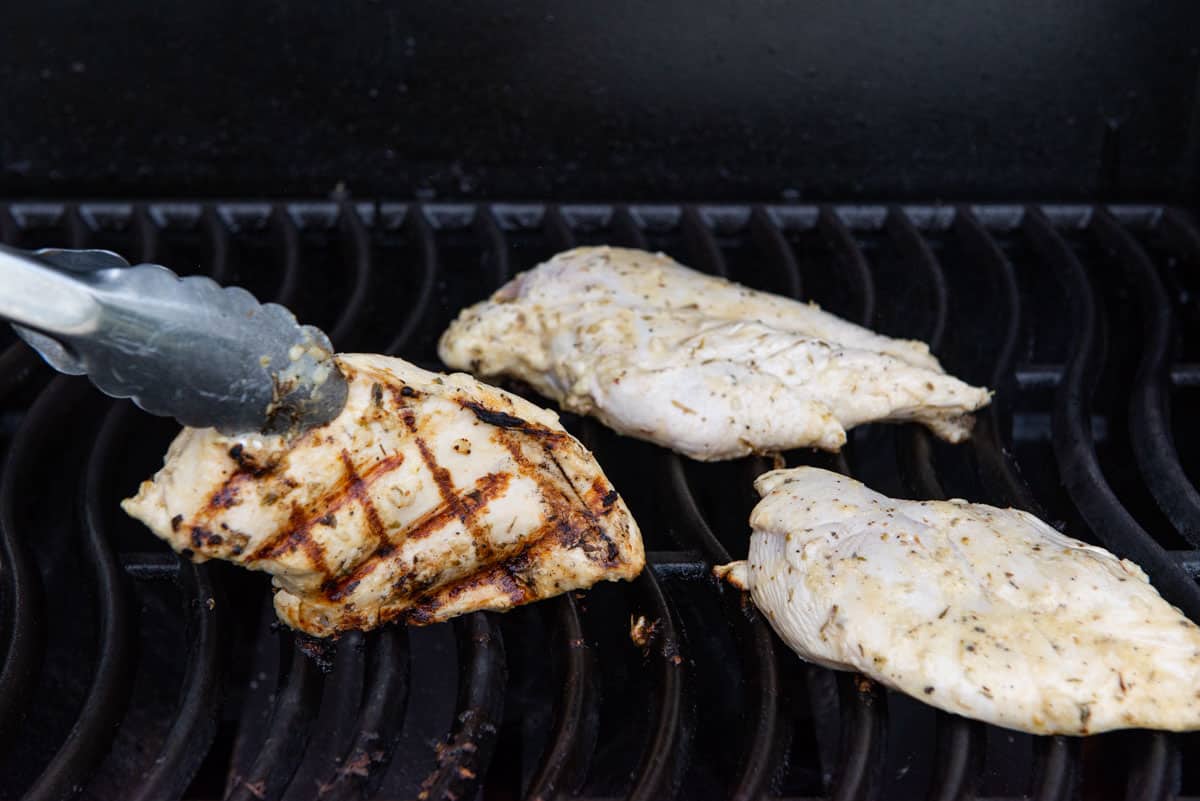
Repeat this cooking pattern on the other side. Close the lid and let cook for 2 minutes, then turn them 90 degrees, and cook for 2 more minutes.
At this point, the meat should be about done.
Check the internal temperature using an instant-read thermometer (affiliate). The recommended internal temperature is 165 degrees F, but because carryover cooking will raise the internal temperature a few degrees after removing the meat from the heat, I pull it off the grill if it’s at least 160F. Here my 162F is perfect!
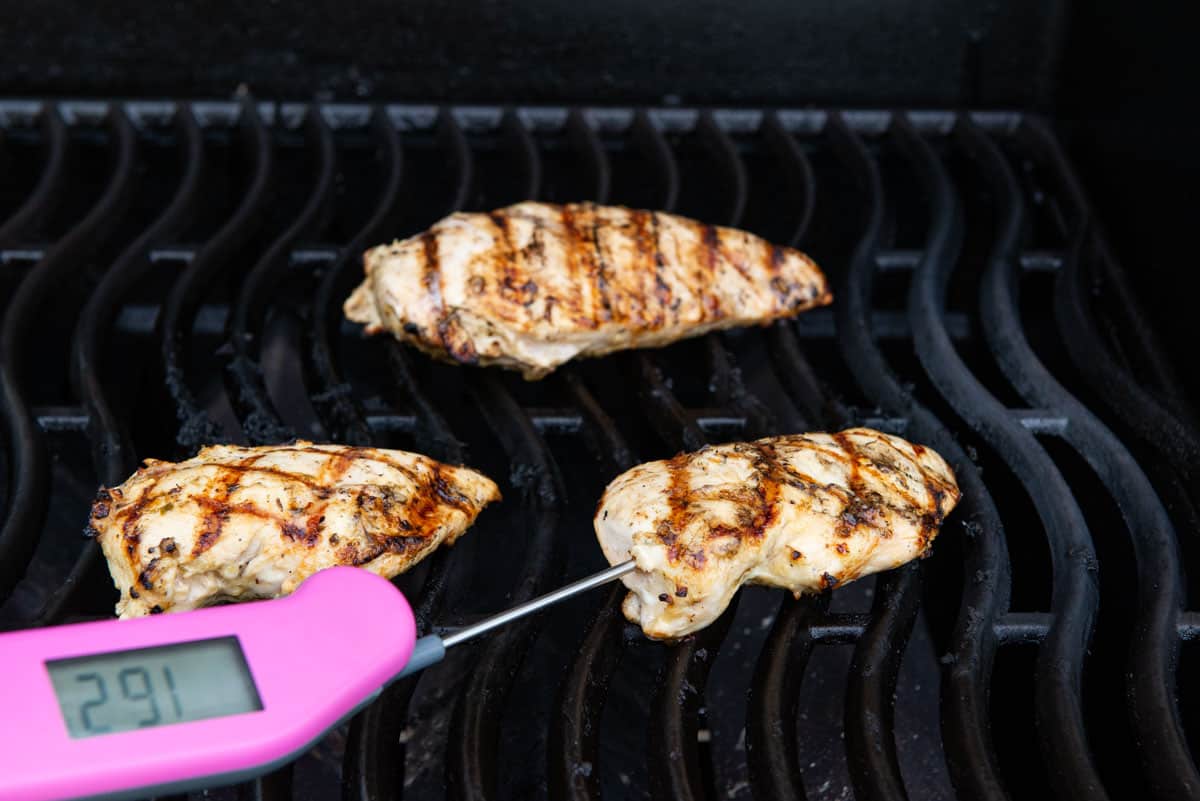
Let the chicken rest on a wire rack or plate for at least 5 minutes, then it’s ready to slice and enjoy.
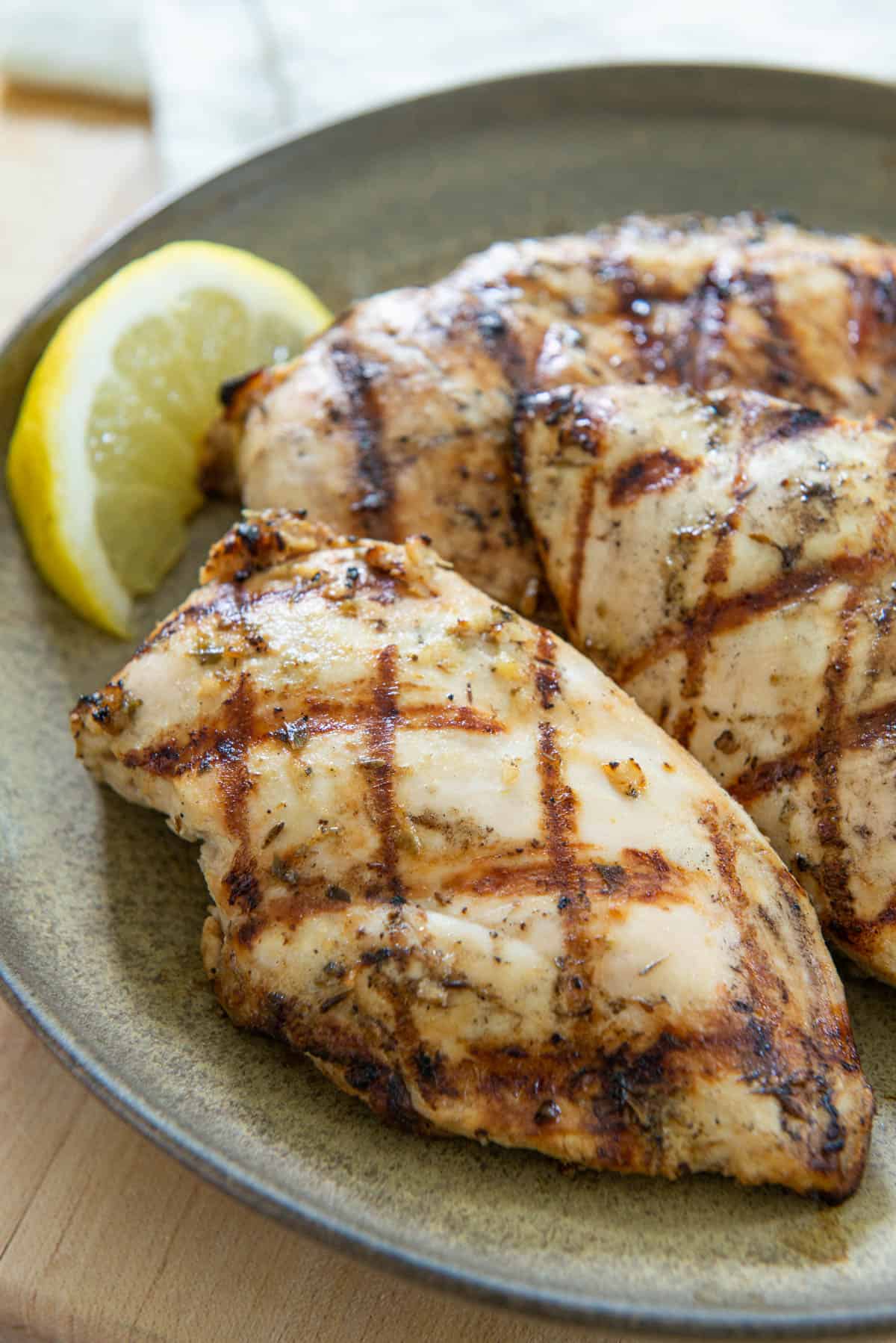
Suggested Sides for This Recipe
This grilled chicken breast recipe pairs with most sides. Here are some of my personal favorite choices.
- Rice Pilaf – Simple but delicious pairing that stores well.
- Red Potato Salad – A classic side for poultry that can be made ahead of time.
- Cilantro Lime Rice – Put lime in the marinade instead and pair it with this rice!
- Corn and Avocado Bean Salad – A hearty side that can also be mostly made ahead.
- Quinoa Cakes – A fancier option which will elevate the dish.
FAQ and Tips
Place in an airtight container and keep in the fridge for up to 5 days.
Yes, chicken freezes beautifully! Store in an airtight container to prevent the meat from absorbing off-flavors, up to 2 months.
The microwave is easiest, and 60 seconds for each breast is a good guideline. With all meats, I like to heat at 70% power. This also tastes pretty good eaten cold, cut up in a salad.
You may use any marinade you like. I also love my Carne Asada marinade for chicken, or you can even use barbecue sauce. Use your storebought favorite or my homemade Sweet and Spicy BBQ Sauce. A dry rub is also great, but it won’t tenderize the meat as well. Try to stay away from rubs with brown sugar, as it tends to scorch on the grill.
An outdoor grill will give you superior flavor, but if the weather is bad, you can use a grill pan instead. I recommend using medium-high heat.
Yes, but you will need to use a meat thermometer to check for doneness, as the different chicken pieces will likely have variations in cook time. The internal temperature of the chicken for dark meat like chicken thighs and drumsticks is 180F instead of 165F.
Did you enjoy the recipe? Please leave a 5-star rating in the recipe card below and/or a review in the comments section further down the page. Or, follow me on Facebook, Instagram or Pinterest!
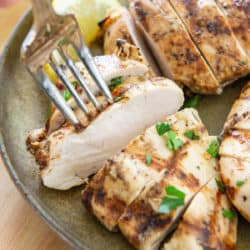
Grilled Chicken Breast on a Gas Grill
Ingredients
For the Marinade*:
- 2 tbsp extra virgin olive oil
- 2 tbsp lemon juice**
- 1 tbsp pressed or minced garlic (4 large cloves)
- 1 tbsp dijon mustard
- 1 tsp kosher salt
- ½ tsp black pepper
- 1 tsp dried thyme
For the Grilled Chicken:
- 3 small chicken breasts (totaling 1.25lbs)
Side Dish Ideas for Pairing:
Instructions
- In a gallon-sized ziptop bag, combine all of the marinade ingredients, swishing them around to mix well.
- If the chicken breasts you're using total 1.25lbs, they will likely be under 1" thick, which is perfect. If yours are not, or if you're using larger breast pieces, pound them with a rolling pin or meat mallet to under 1" thickness.
- Place the chicken breasts in the marinade bag, squeezing all the excess air out. Toss them around in the bag to coat in the marinade, then let sit at room temperature for one hour***. Make sure they are resting on the counter in a single layer, without the breasts on top of each other.
- Preheat all 3 burners of a gas grill over high heat for at least 10 minutes, which should get the internal temperature to at least 600F (once you open the lid and start cooking, it will likely hover around 400F, which is perfect).
- Add the chicken breasts to the grill, close the lid, and let cook for 2 minutes.
- Open the lid, and turn the meat 90 degrees, cooking on the same side for another 2 minutes. This creates grill marks and caramelization going the other way.
- Flip the chicken over, and repeat on the other side, cooking for 2 minutes with the lid closed, then turning 90 degrees, and cooking for 2 more minutes, lid closed.
- Check the internal temperature of the breasts using a thermometer. It's done when it's 160F or above, as it will rise about 5 more degrees from carryover cooking. If the chicken is not 160F, flip the pieces over again (to the first side) and cook for another 2 minutes, lid closed, and check again.
- Let the meat rest for 5 minutes before slicing and serving. Enjoy!
Notes
- Lemon juice – Try an equal amount of lime juice.
- Thyme – You can substitute dried oregano, rosemary, basil, or parsley here, or even do a mix. I like to use dried herbs for convenience, but you can also use fresh. Just double the amount used.
- Olive Oil – You can also use avocado oil here if you prefer.
- Dijon mustard – If you’re not a fan of mustard, feel free to swap in soy sauce, coconut aminos, balsamic vinegar, or a half amount of Worcestershire sauce.
Nutrition
Nutrition is estimated using a food database and is only intended to be used as a guideline for informational purposes.

4 Comments on “Grilled Chicken Breast”
I’ve made it this way for years. Always delicious, juicy, and tender. You can even repackage the chicken with the marinade and keep them in your freezer. Then allow it to thaw in your fridge as it marinates. Pull it out in the morning to thaw and it;s perfect to grill by dinner.
This sounds delicious however I do love the tangy. So 1 hour for the most lemon I will sacrifice the 30 minutes. I will try it out and leave a review 😊
Made this tonight, it was quick, easy and delicious! Definitely will be in the regular rotation. I put the marinade and chicken in a ziplock bag on the counter while I prepped veggies to roast. Thanks for a great recipe!
Hi Sam, that is great! So glad you enjoyed it and made good use of the marinating time. Happy cooking!